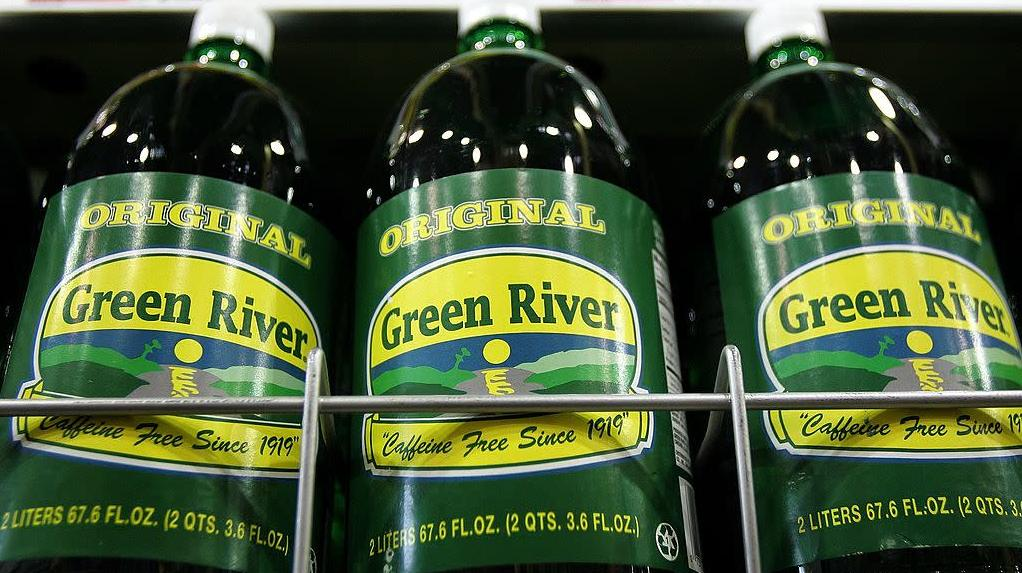It's Easy Being Green: An Appreciation Of Green River Soda
A river runs through every Midwesterner's veins, one spiked with white-hot sugar and the zest of "lively lime." Emboldened by a hundred years and a cult following, just one sip of the stuff sends a thousand-watt jolt through anything with a pulse and a palate. From soda-shop staple to Prohibition changeling, Green River soda has staked its claim on hearts and stomachs across the U.S. heartland for over a century.
More state-of-mind than soda, Green River was usually slung from locally owned diners and hole-in-the-wall soda fountains, the cornerstone of pre-teen happy hour. Bomb that AP History exam? Dude turned you down for Turnabout? Parents are arguing louder than your stereo can blare Minus The Bear? Drown those sorrows on the banks of the Green River—a tincture so tried-and-true that I still lean on it today, easing me through tough times and triumphs in equal measure.
Green River's roots dig back to a wild time when booze did not flow freely and government meddling extended to issues like addressing flood control and policing migratory birds. (Oh, how far we've wandered!) Let's set the scene: It's 1919, and Congress is fresh from passing the 18th Amendment—inciting, y'know, that failed social experiment we now call Prohibition. Breweries and boozers scramble for alcohol-free substitutions as they are forced to bid goodbye to the froth of beer. Hello, soda fizz.
Some topers opted for non-alcoholic beer alternatives appropriately dubbed Near Beer, while others opted for the sweeter side of life, downing sodas and sundaes. Chicago's Schoenhofen Edelweiss Brewing, though, would not go gently into that good, sober night. Schoenhofen Edelweiss was preparing to set sail down the Green River.
Concocted in 1916 by a Davenport, Iowa, soda fountain owner by the name of Richard C. Jones, Green River was mostly a scheme to attract sugar horny high schoolers to Jones' soda fountain. Lucky for Jones, his soda was an instant success in Davenport and beyond, leading Schoenhofen Edelweiss to take notice and purchase the burgeoning brand's recipe in 1919.
It would take three more years before the Green River would begin its downriver-journey toward palates and profits in Chicago. The parakeet-green brew, with its zippy lime base and refreshing, lemony bite, became a regional phenomenon.
To the chagrin of legislators, Prohibition didn't last and was phased out completely in 1933. Green River's popularity continued to coast, though, trailing only Coca-Cola in fountain sales from 1930 to 1950.
The success wouldn't last forever, though. Green River couldn't compete with its boozy brethren, and sales began a steady decline as years passed. Schoenhofen ceased operations in 1950, and the Green River recipe would become ensnared in legal battles, nearly lost to time. Half a decade later, a good samaritan and soft drink saint Ed Kennelly would acquire the recipe, parching thirsty throats within weeks.
Longtime fans embraced its return, one of its most famous being heartland rock titan John Fogerty. His passion for the drink warranted a musical tribute, Creedence Clearwater Revival's 1969 single "Green River," a Southern-fried ditty that skates through the lyrics, "You're gonna find the world is smould'rin' / And if you get lost come on home to Green River." Fogerty said of his devotion: "The drink was a green, lime drink on ice with fizz water, a soggy green snow cone. That's what I would order and it made me the happiest."
Fogerty wasn't alone in his reverence for Green River's transcendent qualities. "Fans of Green River know that it's not just another soda; it's nostalgia in a bottle," its website boldly proclaims. That nostalgia trip is now the lynchpin of Green River's appeal, copping to the fact that the soda transports sippers to "a pleasant time in their life...a time of corner soda fountains and drive-in movies."
Leaning on fond memories and an uncompromising formula, Green River continued to reign as one of the most desirable niche sodas on the market, finding a new home with the WIT Beverage Company in 2011. The acquisition expanded Green River's horizons significantly, even bringing Walgreens into its family of distribution channels.
While Green River has leaned on the nostalgia factor, the company has also become hip to modern times—and marketing. While most Chicagoans dread the imminent, shamrock spangled arrival of St. Patrick's Day, in all its bro hymn glory, that (loose definition of a) holiday does account for a nearly 30% spike in Green River sales. Green River has even leaned into mankind's appetite for destruction, inventing an alcoholic palatal assault dubbed the SUPER Green River Beer Marg that can only be described as the first cousin to Riot Punch™.
There are those who choose to let their memories hang in the sky like stars, those who prefer to keep fond moments bottled and bonded somewhere closer to the heart. Green River is an ideology so simple and true that it can stand the test of time for a hundred years and counting.
